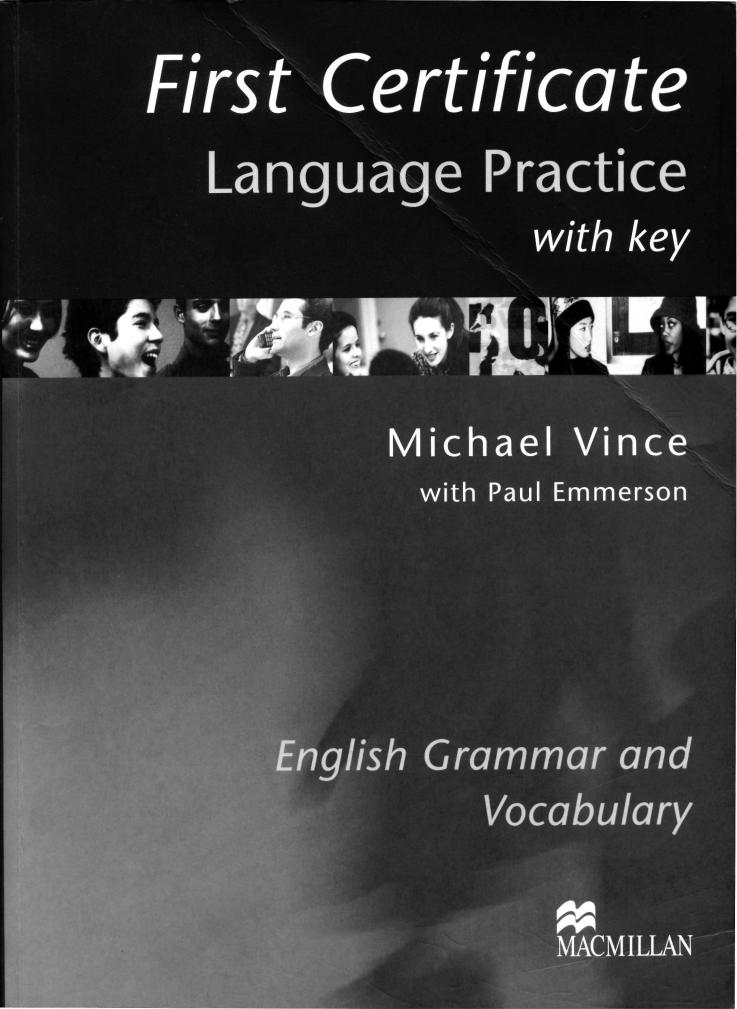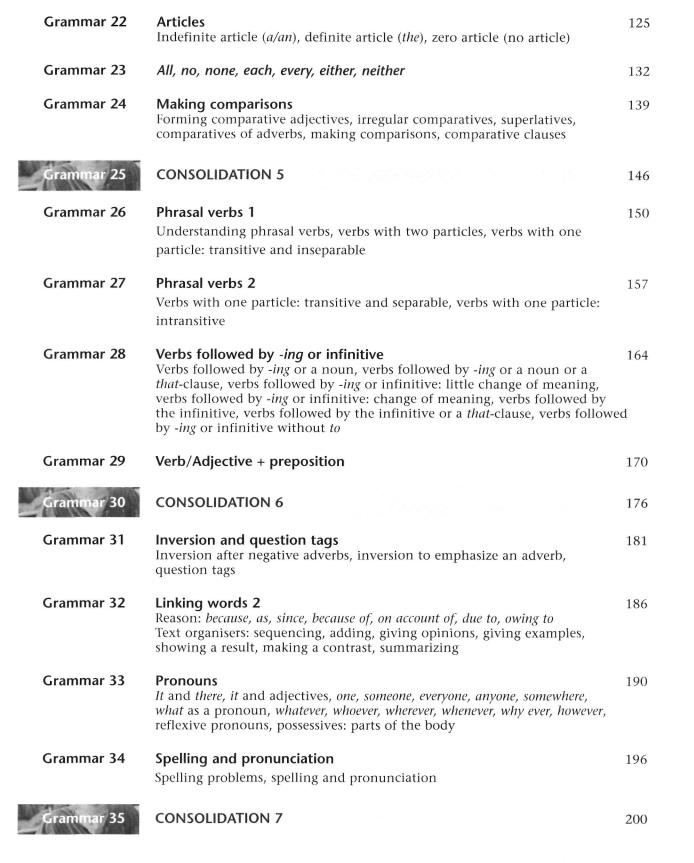
Vince_M_-_FCE_Language_Practice_With_Key_MacMi
.pdf

Macmillan Education
Between Towns Road, Oxford OX4 3PP
A division of Macmillan Publishers Limited
Companies and representatives throughout the world
ISBN 1 405 00765 6 without key
ISBN 1 405 00766 4 with key
Text © Michael Vince 2003
Design and illustration © Macmillan Publishers Limited 2003
First published 1993
This edition published 2003
All rights reserved; no part of this publication may be reproduced, stored in a retrieval system, transmitted in any form, or by any means, electronic, mechanical, photocopying, recording, or otherwise, without the prior written permission of the publishers.
Designed by Mike Brain Graphic Design Limited
Layout and composition by Mike Brain Graphic Design Limited
Illustrated by:
Rowan Barnes-Murphy pp 9, 42; Ben Hasler pp 3, 218;
Ian Kellas pp 96, 97; Gillian Martin pp 141; Janek Matysiak pp 227, 232, 260; Julian Mosedale pp 53, 78, 103, 120, 121, 129, 143, 155, 183, 202, 264, 289; David Parkins pp 18, 145; Martin Shovel pp 36, 61, 84, 107, 127, 135, 153, 160, 192, 214, 248, 282, 295; Bill Stott pp 94, 100, 111.
Photographs by:
Eyewire, Photodisc and Andrew Oliver.
The author would like to thank the many schools and teachers who have commented on these materials. Also special thanks to
Paul Emmerson and Sarah Curtis.
Printed and bound by Scotprint
2007 2006 200S
1 0 9 8 7 6 5 4

Contents
Introduction |
vii |
iii

FIRST CERTIFICATE LANGUAGE PRACTICE


FIRST CERTIFICATE LANGUAGE PRACTICE
Vocabulary |
1 |
Travel and holidays |
203 |
Vocabulary |
2 |
Work and employment |
208 |
Vocabulary |
3 |
Sport and leisure |
213 |
Vocabulary |
4 |
Clothes and appearance |
218 |
Vocabulary |
5 |
Towns and buildings |
222 |
Vocabulary |
6 |
Vehicles and transport |
227 |
Vocabulary |
7 |
Food, restaurants and cooking |
231 |
Vocabulary |
8 |
Shops and shopping |
235 |
Vocabulary |
9 |
Crime and the law |
240 |
Vocabulary 10 |
Entertainment and the arts |
245 |
|
Vocabulary 11 |
The natural world |
250 |
|
Vocabulary 12 |
People and behaviour |
254 |
|
Vocabulary 13 |
Technology and machines |
259 |
|
Vocabulary 14 |
Problems |
264 |
|
Vocabulary 15 |
Health and the body |
269 |
|
Vocabulary 16 |
Money |
274 |
|
Vocabulary 17 |
Feelings and opinions |
278 |
|
Vocabulary 18 |
Education and learning |
282 |
|
Vocabulary 19 |
Word formation 1 |
287 |
|
Vocabulary 20 |
Word formation 2 |
291 |
|
Vocabulary 21 |
Collocations |
296 |
|
|
|
Formation rules |
300 |
|
|
Word list |
302 |
|
|
Grammar index |
311 |
|
|
Grammar answers |
313 |
|
|
Vocabulary answers |
330 |
VI

This book is designed to revise and consolidate grammar points at the level of First Certificate. It also provides practice in key lexical areas.
There are regular consolidation units which include forms of testing commonly used in the First Certificate examination.
It can be used as a self-study reference grammar and practice book, or as supplementary material in classes preparing for examinations.
If used for classwork, activities can be done individually or co-operatively in pairs or small groups. The grammatical information provided can be used for reference when needed, or worked through systematically
The grammar section includes recognition and concept-checking activities, as well as production activities.
Each vocabulary section includes focus on phrasal verbs, prepositions and particles, and collocations.

Explanations
Describing events |
• |
Main events |
|
in the past |
|
The past simple is used to describe finished actions and events in the past. |
|
|
|
Susan went into the station and bought a ticket. |
|
|
- |
Background |
description |
|
|
The past continuous is used to describe actions in progress in the past. It |
|
|
|
gives information about the background situation. |
|
|
|
There were a lot of people waiting in the station. Some were sleeping on the |
|
|
|
benches, |
and others were walking up and down. Susan was looking for |
|
|
Graham, |
so she didn't sit down. |
|
• |
Past before |
past |
The past perfect is used to make it clear that one past event happens before
another past event. We use the past perfect for the earlier event.
By the time the train arrived, Susan had managed to push her way to the front of the crowd.
It is not always necessary to use the past perfect if a time expression makes the order of events clear.
Before the train arrived, Susan managed to push her way to the front of the crowd.
- Past continuous used with past simple
We often use the past continuous first to set the scene, and then the past simple for the separate, completed actions that happen.
Susan was looking for Graham, so she didn't sit down. Instead, she tried calling him on her mobile phone.
We often contrast an action in progress with a sudden event which interrupts it.
While Susan was trying to get onto the platform, a man grabbed her handbag.
|
• |
Participle clauses |
|
|
|
Participle clauses are introduced by the time expressions before, after and |
|
|
|
while. They have the same subject as the following clause. |
|
|
|
After struggling with him, Susan pulled the bag from his hands. |
|
Habits in the past |
• |
Past simple |
|
|
|
The past simple is used to describe past habits or states. A time expression is |
|
|
|
usually necessary. |
|
|
|
/ always got up at six in those days, |
(habit) |
|
|
/ lived in Austria for several years. |
(state) |
1
FIRST CERTIFICATE LANGUAGE PRACTICE
•Used to
Used to is used to describe past habits or states. A time expression is not necessary.
J used to get up at six, but now I get up at eight.
I used to own a horse. (I owned a horse once.)
With negatives and questions used to becomes use to.
I didn't use to like beer.
Did you use to swim every day?
When we use used to we suggest that the action is no longer true and so make a strong contrast with the present.
• Would
Would is used to describe a person's typical activities in the past.
It can only be used to describe repeated actions, not states. It is mainly used in writing, and in personal reminiscences.
Every evening was the same. Jack would turn on the radio, light his pipe and fall asleep.
• Past continuous
The past continuous can be used to describe a repeated action in the past, often an annoying habit. A frequency adverb is necessary.
|
When |
Peter was younger, he was always getting into trouble. |
Politeness and |
We can use the past continuous with think, hope and wonder to give a polite or |
|
uncertainty |
uncertain meaning. |
|
|
I was |
thinking of having a party next week. |
|
I was |
hoping you would join us at the cafe tonight. |
|
I was |
wondering if you could help me. |
2
